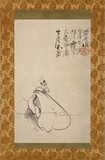Fūgai was a Sōtō Zen sect monk who spent most of his life wandering and remaining alone to meditate. He was an early proponent of a style later called Zenga, breaking from Muromachi styles by placing his figures (mostly Hotei and Daruma) against a blank ground to call attention to their poses and expressions.
Fūgai was born in an agricultural village, Hijishio, and at age 4 or 5 was placed at Kansōji, an esoteric Shingon sect temple. He would move after a few years to Chōgenji in nearby Shizuoka Prefecture, where he was introduced to Sōtō Zen. At age 16 he began traveling to learn further about Zen, studying with Jizen Gen'etsu (d. 1589) and Ketsuzan Gensa (d. 1609) at Sōrinji in present Gunma Prefecture. Around 1596, he began a wandering pilgrimage, studying with Rinzai sect monks and thereafter becoming interested in painting and calligraphy. Fūgai briefly returned to present Kanagawa prefecture where he served for two years as the abbot of the temple Jōganji. Challenging himself beyond temple life, Fūgai thereafter wandered and meditated, living often for a year or two in caves. He appreciated the deprivation of his senses, which allowed him greater concentration in his meditation, and to eat rice, he would trade paintings to local farmers. In 1628, Fūgai left his cave abode and moved to the village of Manazuru, whose village headman built him a hut near the local Tenshin Shrine in 1630. Like Hotei (Pudai, a wandering monk of the 10th century), Fūgai's companions in the village were its children, the adults being engrossed in daily labors.
Ekun Fūgai
6 records
Include records without images
About this artist




